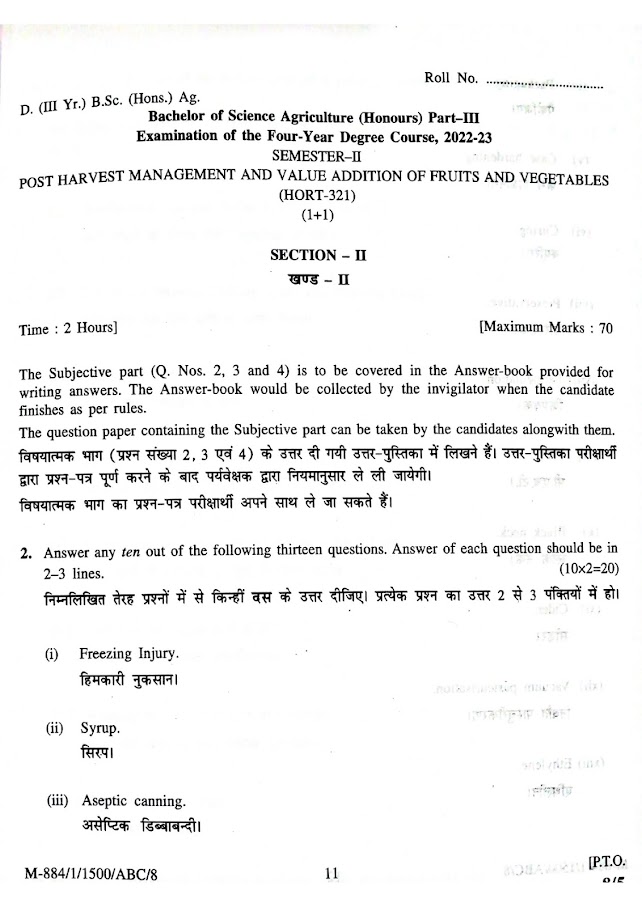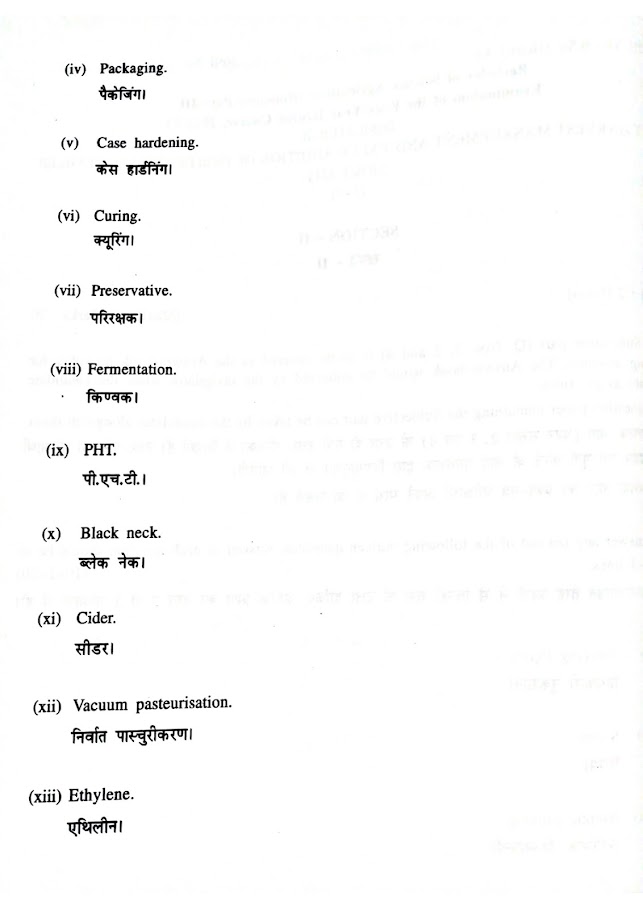2022-23 Solved Old Paper (HORT - 321) OK
SECTION - I
Fill in the Blank Type Questions:-
Q.1. Canning is a method of preserving food by sealing it in __________ containers.
(Canning एक विधि है जिसमें भोजन को __________ कंटेनरों में सील करके संरक्षित किया जाता है।)
Answer: airtight (हवा बंद)
Q.2. The process of ________ helps to destroy microorganisms in canned food.
(________ प्रक्रिया डिब्बाबंद भोजन में सूक्ष्मजीवों को नष्ट करने में मदद करती है।)
Answer: Heat Treatment (हीट ट्रीटमेंट)
Q.3. FDA guidelines are essential for ensuring food __________ in the canning process.
(FDA दिशानिर्देश कैनिंग प्रक्रिया में भोजन की __________ सुनिश्चित करने के लिए आवश्यक हैं।)
Answer: safety (सुरक्षा)
Q.4. Before sealing, food is packed into cans along with necessary __________.
(सील करने से पहले, भोजन को आवश्यक __________ के साथ डिब्बों में भरा जाता है।)
Answer: liquids (तरल पदार्थ)
Q.5. In the U.S., __________ sets safety standards for canned foods.
(अमेरिका में, __________ डिब्बाबंद खाद्य पदार्थों के लिए सुरक्षा मानक निर्धारित करता है।)
Answer: FDA
Q.6. Cans are often coated with a layer of __________ to prevent rusting.
(जंग से बचने के लिए डिब्बों को अक्सर __________ की परत के साथ लेपित किया जाता है।)
Answer: tin (टिन)
Q.7. The purpose of __________ testing is to detect microbial contamination in canned products.
(__________ परीक्षण का उद्देश्य डिब्बाबंद उत्पादों में सूक्ष्मजीव संदूषण का पता लगाना है।)
Answer: Microbiological (सूक्ष्मजीविकीय)
Q.8. Retort pouches are made from __________ materials designed to withstand the canning process.
(रेटॉर्ट पाउच __________ सामग्रियों से बने होते हैं, जो कैनिंग प्रक्रिया को सहन करने के लिए डिज़ाइन किए गए हैं।)
Answer: multi-layered (मल्टी-लेयर्ड)
Q.9. Cans must be labeled with information such as __________, ingredients, and expiration dates.
(डिब्बों पर __________, सामग्री और समाप्ति तिथि जैसी जानकारी लेबल की जानी चाहिए।)
Answer: product name (उत्पाद का नाम)
Q.10. HACCP is a systematic approach to __________ in food processing.
(HACCP भोजन प्रसंस्करण में __________ के लिए एक व्यवस्थित दृष्टिकोण है।)
Answer: safety (सुरक्षा)
Q.11. Codex Alimentarius provides international guidelines for the __________ of canned foods.
(कोडेक्स एलीमेंटेरियस डिब्बाबंद खाद्य पदार्थों के __________ के लिए अंतरराष्ट्रीय दिशानिर्देश प्रदान करता है।)
Answer: safe production (सुरक्षित उत्पादन)
Q.12. A vacuum seal inside the can helps to prevent __________.
(डिब्बे के अंदर वैक्यूम सील __________ को रोकने में मदद करता है।)
Answer: spoilage (सड़न)
Q.13. After heat treatment, cans are quickly __________ to maintain the vacuum seal.
(हीट ट्रीटमेंट के बाद, वैक्यूम सील को बनाए रखने के लिए डिब्बों को जल्दी से __________ किया जाता है।)
Answer: cooled (ठंडा किया जाता है)
Q.14. Sustainable canning practices include recycling __________.
(सतत कैनिंग प्रथाओं में __________ को रीसायकल करना शामिल है।)
Answer: metal cans (धातु के डिब्बे)
Q.15. The size of the can is determined by the type of product and __________ demand.
(डिब्बे का आकार उत्पाद के प्रकार और __________ मांग द्वारा निर्धारित किया जाता है।)
Answer: consumer (उपभोक्ता)
MCQs Type Questions:-
Q.1. What is the primary purpose of canning?
कैनिंग का मुख्य उद्देश्य क्या है?
A. To enhance the flavor of food (खाद्य के स्वाद को बढ़ाने के लिए)
B. To seal food in airtight containers (खाद्य को वायुरुद्ध कंटेनरों में बंद करने के लिए)
C. To reduce nutritional value (पोषण मूल्य को कम करने के लिए)
D. To increase the weight of food (खाद्य के वजन को बढ़ाने के लिए)
Q.2. What is the main material used for making standard cans?
मानक कैन बनाने के लिए मुख्य सामग्री क्या है?
A. Plastic (प्लास्टिक)
B. Aluminum (एल्यूमीनियम)
C. Glass (कांच)
D. Paper (कागज)
Q.3. What is the purpose of the liner coating inside metal cans?
धातु कैन के अंदर लाइनर कोटिंग का उद्देश्य क्या है?
A. To prevent rusting (जंग लगने से रोकने के लिए)
B. To increase weight (वजन बढ़ाने के लिए)
C. To add flavor (स्वाद जोड़ने के लिए)
D. To reduce cost (लागत कम करने के लिए)
Q.4. What is the primary objective of the HACCP system in canning?
कैनिंग में HACCP प्रणाली का प्राथमिक उद्देश्य क्या है?
A. Enhancing product appearance (उत्पाद की उपस्थिति को बढ़ाने के लिए)
B. Controlling potential hazards (संभावित खतरों को नियंत्रित करने के लिए)
C. Reducing can size (कैन के आकार को कम करने के लिए)
D. Increasing shelf life (शेल्फ जीवन बढ़ाने के लिए)
Q.5. Which type of packaging is commonly used for ready-to-eat meals?
तैयार-से-खाने के भोजन के लिए आमतौर पर किस प्रकार की पैकेजिंग का उपयोग किया जाता है?
A. Standard Cans (मानक कैन)
B. Retort Pouches (रीटॉर्ट पाउच)
C. Glass Jars (कांच के जार)
D. Plastic Bottles (प्लास्टिक की बोतलें)
Q.6. What is the typical temperature treatment during the canning process?
कैनिंग प्रक्रिया के दौरान सामान्य तापमान उपचार क्या होता है?
A. To freeze food (खाद्य को जमा देने के लिए)
B. To boil food (खाद्य को उबालने के लिए)
C. To destroy microorganisms (सूक्ष्मजीवों को नष्ट करने के लिए)
D. To add preservatives (परिरक्षकों को जोड़ने के लिए)
Q.7. Which organization sets international food safety standards for canned products?
डिब्बाबंद उत्पादों के लिए अंतरराष्ट्रीय खाद्य सुरक्षा मानक कौन सी संस्था निर्धारित करती है?
A. FAO/WHO (एफएओ/डब्ल्यूएचओ)
B. UNICEF (यूनिसेफ)
C. UNESCO (यूनेस्को)
D. WTO (डब्ल्यूटीओ)
Q.8. What is the purpose of blanching during the canning process?
कैनिंग प्रक्रिया के दौरान ब्लांचिंग का उद्देश्य क्या है?
A. To reduce acidity (अम्लता को कम करने के लिए)
B. To kill bacteria (बैक्टीरिया को मारने के लिए)
C. To preserve flavor and color (स्वाद और रंग को संरक्षित करने के लिए)
D. To increase can size (कैन का आकार बढ़ाने के लिए)
Q.9. Which type of can is most resistant to corrosion?
कौन सा कैन सबसे अधिक संक्षारण प्रतिरोधी है?
A. Steel Cans (स्टील कैन)
B. Aluminum Cans (एल्यूमीनियम कैन)
C. Plastic Cans (प्लास्टिक कैन)
D. Glass Cans (कांच के कैन)
Q.10. What information must be included on can labels?
कैन लेबल पर कौन सी जानकारी शामिल होनी चाहिए?
A. Barcode and QR code (बारकोड और क्यूआर कोड)
B. Nutritional facts and expiration date (पोषण तथ्य और समाप्ति तिथि)
C. Manufacturer's name only (केवल निर्माता का नाम)
D. Storage instructions only (केवल भंडारण निर्देश)
Q.11. What is the purpose of rapid cooling in the canning process?
कैनिंग प्रक्रिया में तेजी से ठंडा करने का उद्देश्य क्या है?
A. To prevent overcooking (अधिक पकने से रोकने के लिए)
B. To increase can weight (कैन का वजन बढ़ाने के लिए)
C. To enhance flavor (स्वाद को बढ़ाने के लिए)
D. To add preservatives (परिरक्षकों को जोड़ने के लिए)
Q.12. Which testing method is used to detect microbial contamination in canned foods?
डिब्बाबंद खाद्य पदार्थों में सूक्ष्मजीव संदूषण का पता लगाने के लिए कौन सी परीक्षण विधि का उपयोग किया जाता है?
A. Visual Inspection (दृश्य निरीक्षण)
B. Microbiological Testing (सूक्ष्मजीव परीक्षण)
C. Physical Testing (भौतिक परीक्षण)
D. Chemical Testing (रासायनिक परीक्षण)
Q.13. What is a common alternative to metal cans for packaging?
पैकेजिंग के लिए धातु कैन का सामान्य विकल्प क्या है?
A. Aseptic Packaging (एसेप्टिक पैकेजिंग)
B. Paper Bags (कागज के थैले)
C. Glass Bottles (कांच की बोतलें)
D. Wooden Boxes (लकड़ी के बॉक्स)
Q.14. Why is it important to maintain a vacuum seal in canned foods?
डिब्बाबंद खाद्य पदार्थों में वैक्यूम सील बनाए रखना क्यों महत्वपूर्ण है?
A. To prevent air entry (हवा के प्रवेश को रोकने के लिए)
B. To add weight (वजन बढ़ाने के लिए)
C. To reduce acidity (अम्लता को कम करने के लिए)
D. To enhance flavor (स्वाद को बढ़ाने के लिए)
Q.15. What is the focus of sustainability efforts in the canning industry?
कैनिंग उद्योग में स्थिरता प्रयासों का फोकस क्या है?
A. Recycling metal cans (धातु कैन का पुनर्चक्रण)
B. Increasing can size (कैन का आकार बढ़ाना)
C. Reducing nutritional value (पोषण मूल्य को कम करना)
D. Using plastic materials (प्लास्टिक सामग्री का उपयोग करना)



